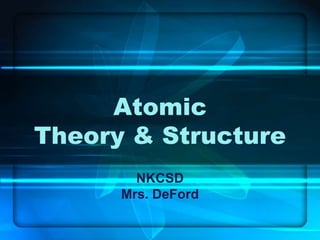
Atomic Theory & Structure
- 1. Atomic Theory & Structure NKCSD Mrs. DeFord
- 2. Learning Objectives • You should be able to: – Discuss the development of the atom from its earliest model to the modern day atom. – Identify the correct number of subatomic particles for atoms, ions, and isotopes. – Calculate the average atomic mass and mass number of an atom from isotopic data.
- 3. Atoms & Elements • An atom is the smallest particle of an element that retains it identity in a chemical reaction. • Elements are the simplest form of matter that has a unique set of properties; an element cannot be broken down into simpler substances by chemical means.
- 4. THE LEGACY OF THE ATOM
- 5. Ancient Philosophy • Who: Democritus (460 BC – 370 BC) • When: 400 BC • Where: Greece • What: Democritus believed that matter was made of small particles he named “atomos”. Democritus believed that atoms were indivisible and indestructible, and that different types of atoms had different sizes and shapes. • How: Democritus used observation and inference to explain the existence of everything; examined broken sea shells to generate his concept of atoms.
- 6. Atomic Theory • Who: John Dalton (1766-1844) • When: 1803 • Where: England • Why: Building on the ideas of Democritus in ancient Greece; applied scientific reasoning. • What: ”Billiard Ball Model” -Described atoms as tiny invisible particles that could not be created, destroyed, or divided. Thought each element was made of its own kind of atom. • How: Studied gases, pressure and temperature changes.
- 7. 4 Hypotheses of Dalton’s Atomic Theory 1. All matter is composed of tiny particles called atoms. 2. Atoms of the same element are identical. The atoms of any one element are different from those of any other element. 3. Atoms of different elements can physically mix together or can chemically combine in simple whole- number ratios to form compounds. 4. Chemical reactions occur when atoms are separated, joined, or rearranged. Atoms of one element, however, are never changed into atoms of another element as a result of a chemical reaction. Dalton’s Atomic Theory
- 8. John Dalton Billiard Ball Model
- 9. Foundations of Atomic Theory Law of Definite Proportions (Proust) The fact that a chemical compound contains the same elements in exactly the same proportions by mass regardless of the size of the sample or source of the compound. Law of Multiple Proportions (Dalton) If two or more different compounds are composed of the same two elements, then the ratio of the masses of the second element combined with a certain mass of the first elements is always a ratio of small whole numbers. Law of Conservation of Mass (Lavoisier) Mass is neither destroyed nor created during ordinary chemical reactions.
- 10. Discovery of Electrons • Who: J. J. Thomson (1856-1940) • When: 1897 • Where: England • What: ”Plum Pudding Model” –Described atoms as a solid sphere of positively charged material having negatively charged electrons spread throughout. Thomson discovered that electrons were smaller particles of an atom and were negatively charged. • Why: Thomson knew atoms were neutrally charged, but couldn’t find the positive particle. • How: Cathode Ray Experiment
- 11. J. J. Thompson Plum Pudding Model
- 12. Atomic Structure I • Who: Ernest Rutherford (1871-1937) • When: 1911 & 1920 • Where: England • What: “Planetary Model” -Decided that atoms were mostly empty space, but had a dense central core (nucleus-1911) consisting of positively charged protons (1920); electrons orbit the nucleus. • Why: He knew that atoms had positive and negative particles, but could not decide how they were arranged. • How: Gold Foil Experiment – isolated the protons.
- 14. Atomic Structure II • Who: Niels Bohr (1885-1962) • When: 1913 • Where: England • What: “Bohr Model” -Proposed that electrons traveled in fixed paths (energy levels) around the nucleus; every atom has a defined number of energy levels. Scientists still use the Bohr model to show the number of electrons in each orbit around the nucleus. • Why: Bohr was trying to show why the negative electrons were not sucked into the nucleus of the atom. • How: Worked with frequency and wavelength of radiation; applied math.
- 16. Modern Concept of the Atom • Electrons travel around the nucleus in random orbits. • Scientists cannot predict where they will be at any given moment. • Electrons travel so fast, they appear to form a “cloud” around the nucleus. • The analogy is that of a “beehive” where the bees are the electrons moving around the nucleus in a “cloud” of energy levels. • Major contributions from many scientists, including Schrödinger (1926) and Chadwick (1932).
- 17. Modern Concept of the Atom • Who: Erwin Schrödinger (1887-1961) • When: 1926 • Where: Austria • What: “Electron Cloud Model” -Proposed that electrons are not confined to fixed energy levels; rather they occupy volumes of space outside the nucleus; electron energy is based on its location (increases away from nucleus) • How & Why: Used math to explain the probable location of electrons; the denser the electron cloud, the more likely the electron will be there.
- 19. Modern Concept of the Atom • Who: James Chadwick (1891-1974) • When: 1932 • Where: England • What: “Nuclear Model” –Discovered the neutron; proposed that neutrons are neutral particles located in the nucleus of an atom and have a mass about that of a proton. • Why: Expanded upon Rutherford’s experiments; If nuclei contained only protons their charge would be much higher than measurements suggested. • How: Used a neutron chamber in his experiments.